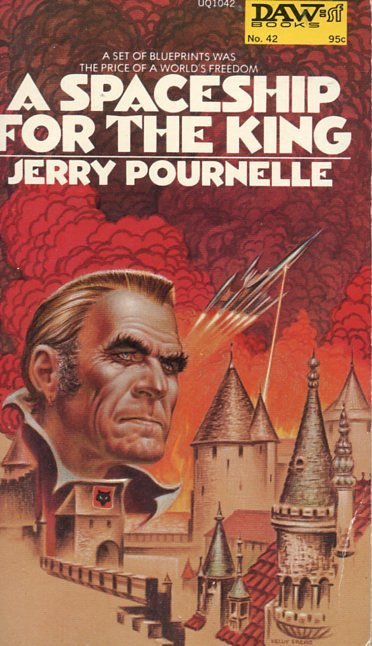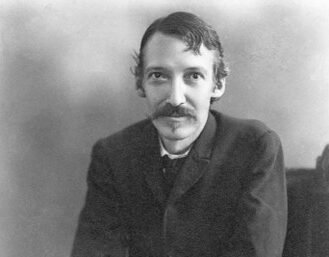A Spaceship for the King

I stumbled on this great retrospective on Jerry Pournelle’s A Spaceship for the King on the Castalia House blog while looking for something else. This particular post was mostly about Jerry’s influence on the Traveller RPG, but I want to look at some other things as well. Let’s take a snippet of what Jeffro said about it:
I say all that because I’m going to make a claim that will be hard for many to accept: that Jerry Pournelle is responsible for creating what would go on to inspire the jump drive of the most popular and best developed science fiction role-playing game. Here is the passage from A Spaceship for the King that I think made a direct impact on the formation of Traveller:
“There’s two kinds of drive, normal space and hyperspace. In normal space, the fusion drive works into a Langston Field releasing photons which propel the ship right. Never mind, I’m not allowed to explain it to you anyway. But this pushes the ship right along, and we experience acceleration from it. The hyperspace drive works on a different principle. It only works along the pseudo nuclear force path between two stars. I don’t suppose that means anything to you. There are force paths between the stars similar to the forces that hold atomic particles together. They fade off rapidly in an exponential relation to distance– oh, hell, that doesn’t tell you anything either. What’s important is that the drive won’t work if you’re near a sun or a planetary body. You have to get a long way out from the primary to get into hyperspace, and it kicks you out when you get close to anything. So once we get decelerated to a speed not too great relative to the sun we’re leaving, we can get into the hyperspace path between the stars. In there we can go faster than light.” (p. 60)
Now, these days the idea that ships would have a separate drive for each of maneuver and faster than light travel is so ubiquitous that it’s hard to imagine anyone ever coming up with it in the first place. And I have no doubt that there are many other stories that have that element before the publication of this novel.
The vibe of this book is one of my favorite things about it. Just look at that DAW Books cover! Jerry later revised A Spaceship for the King into King David’s Spaceship, which I reviewed in 2020. This book has been a favorite of mine for a couple of decades now. It is a classic adventure story, but with a depth of historical and psychological subtlety that you can keep coming back to.
However, I also stumbled on the Kirkus Review of King David’s Spaceship, which I will excerpt:
A disappointingly superficial ""pre-quel"" to the Niven-Pournelle success, The Mote in God's Eye. Here the future-history focus is on Prince Samual's World--a down-at-heels planet that's been contacted by the CoDominium Imperial Navy from the outer galaxies.
…
Space opera with a dab of civilization-conscious theme-weaving, but the comic-strip characters and blastoff action make it mostly a for-kids-only item.
To say that I disagree with this would be putting it mildly. Something I have noticed is that any kind of adventure story, no matter how well written or sophisticated, is said to be “for children”. You can see another example in John C. Wright’s Capsule History of English Science Fiction and Fantasy:
However, the next generation of science fiction writers, including figures like Edgar Rice Burroughs, A. Merritt, and Robert E. Howard, wrote boy’s adventure fiction. Beloved as these stories are to fans like myself, they were comicbookish, aimed at children, and dealt with their themes in a childish way.
These stories are, in my fanboy opinion, simply great, but simply not great art.
I find this really odd. What exactly counts as a “serious” or “literary” story by this criterion? Something I would feel uncomfortable letting my kids read? Does it need to be depressing, or just include explicit sexual content? I know from JD Cowan’s The Last Fanatics that this was a favorite tactic of the Futurians, but it was not original with them.

Alexander Palacio has a great Twitter thread that explains the way in which the Bloomsbury Group used this tactic to tarnish the reputation of Robert Louis Stevenson for much of the twentieth century. With the Bloomsbury group, I do know that their criteria tended toward both depressing and sexually explicit works, but what I don’t understand is why people who don’t share the worldview or lifestyle of the famously bohemian Bloomsbury Group would repeat this slander.
There are some great books written for boys, including many by Stevenson. Jerry even wrote some himself. But it is silly to dismiss works like A Spaceship for the King in this manne.
Comments ()